Yes! I'd like to be contacted to schedule a consultation!
You may have mastered mechanical contracting and have a leg up on your competition with your dedicated customer service. However, without a solid web presence, you could be left behind by one of your more internet-savvy competitors.
Don’t let this happen to you and your hardworking team.
In this guide, LinkNow Media’s search engine optimization (SEO) specialists walk you through everything you need to know about SEO for HVAC contractors. We explain why having a secure, quick-loading, and content-rich site matters, how to make sure your business gets found online among the sea of your competition, how to build your brand’s authority, and what to expect when you follow our SEO and answer engine optimization (AEO) recommendations.
This wisdom will help you position your HVAC company as an industry leader, connect with your target audience where they are in their buyer’s journey, and capture more qualified leads.
You know the inner workings of heating and cooling systems scaled to various building sizes and temperature control complexities. We understand the nuances of making your website rank well on search engines like Google, Yahoo!, and Bing.
Let us tell you more about calibrating your site to reach real people in your area who are in the market for your home and commercial HVAC products and services.
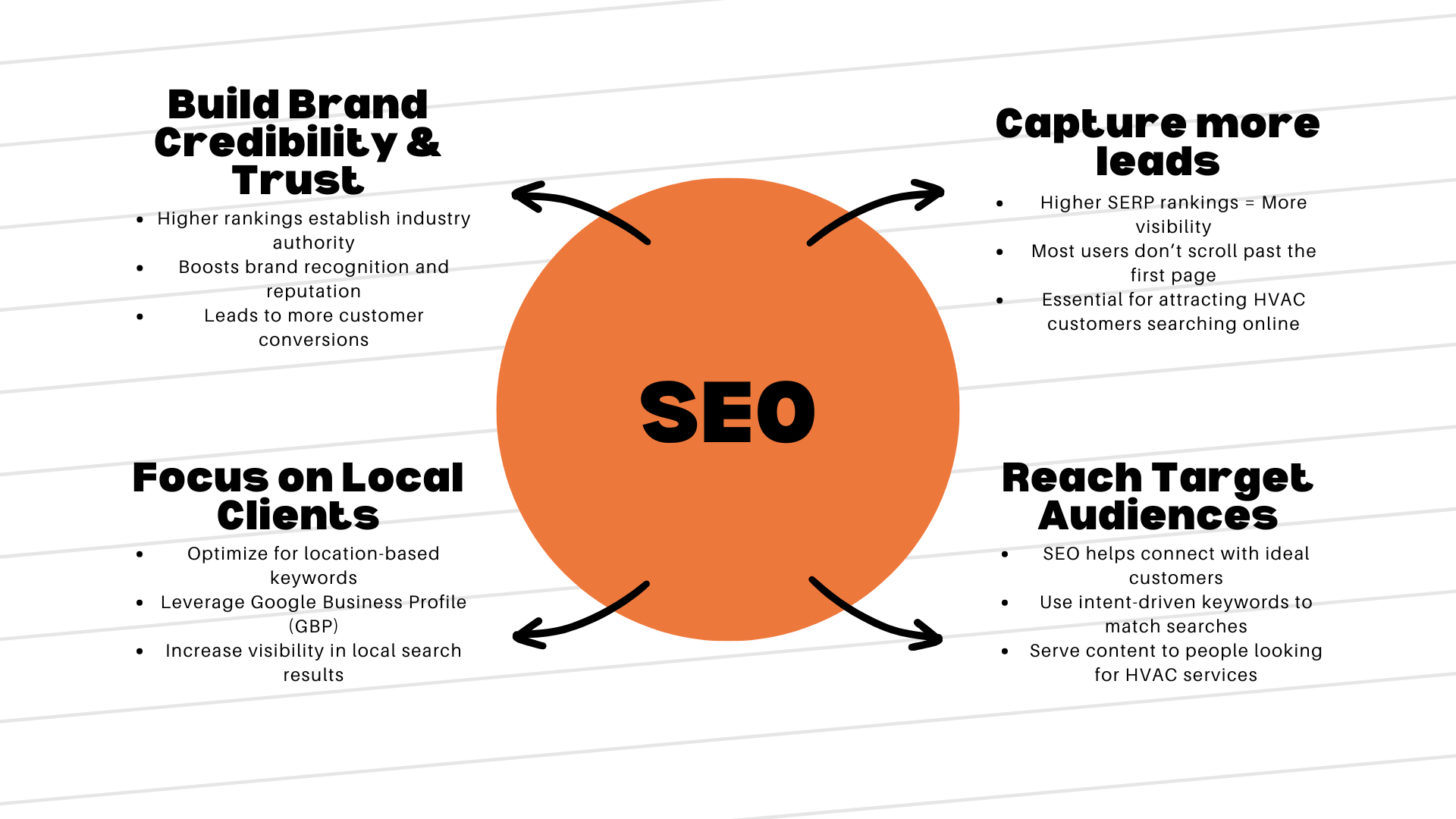
You may have heard by now that having your mechanical contracting business rank on the first page of Google’s search results is the best way to attract leads. This advice is often repeated, but sometimes it’s easier said than done—especially for busy HVAC technicians like you who are focused on delivering swift solutions.
What is SEO? Do all the traditional SEO tips still work? Are there still advantages of optimizing each of your site’s pages?
In short, SEO is the process of optimizing specific web presence elements to achieve a higher ranking on search engine results pages (SERPs). It’s how you outrank your competitors and ensure prospective clients can find you when they’re looking for heating and cooling expertise online.
With SEO best practices in place, HVAC contractors can:
Imagine SEO as a tree with many branches that all function in unison. SEO has many moving parts, all of which work together to create the perfect balance, positioning your business at the top of SERPs.
Let’s break it down.
On-page SEO encompasses everything you can control within a particular page of your website.
This includes:
Let’s explore how tweaking these on-page aspects improves UX and your site’s indexability.
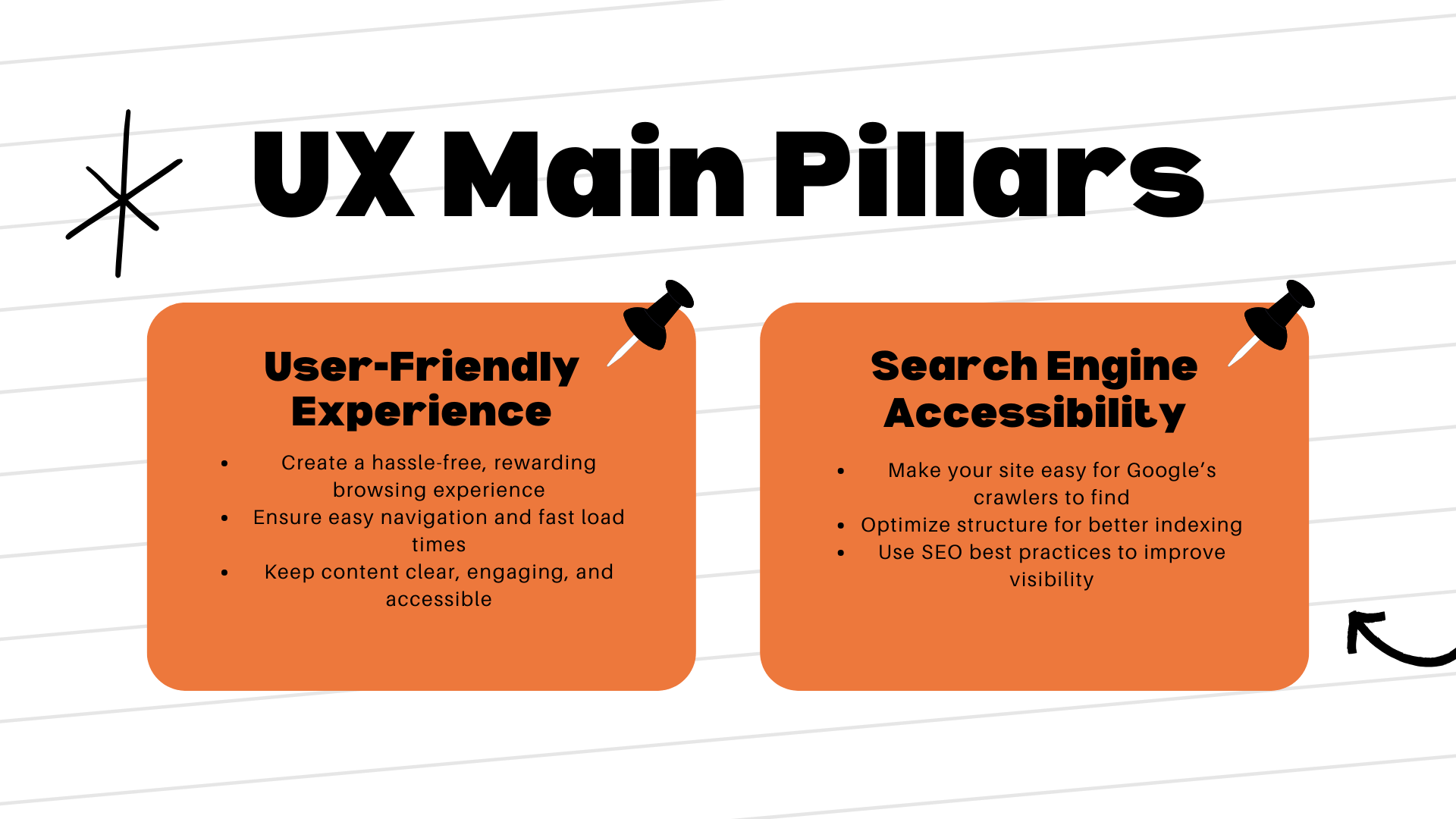
Before we reveal all of search engine optimization’s best practices, let’s discuss user experience (UX) and why it’s fundamental to gaining traction online.
UX has two main pillars.
The first focuses on creating an easy, hassle-free, and rewarding browsing experience for your users. The second focuses on making your site easy for Google’s crawlers (sometimes called spider bots) to find and index.
Fulfilling these objectives should be your primary focus because that’s how you’ll resonate with the users and search engines.
Keywords signal the meaning of each of your website pages to users and search engines. The best practice is to establish a primary or main keyword to build each page around, using related and long-tail secondary keywords to flesh out your content.
Use tools like Ahrefs and Keywordtool.io to generate lists of keyword clusters for specific primary keywords—essentially groups of keywords that all relate to your primary keyword in some way. Choose relevant search terms with decent search volume and use these clusters in your subheadings (h2, h3, h4, etc.) to help your audience find the information they want.
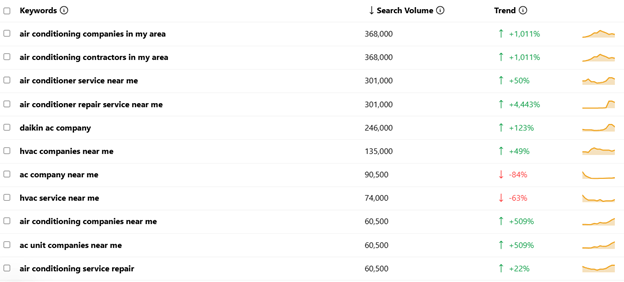
Keyword tools also give you more information about how competitive keywords are, so you’ll know if they’re a good fit for your content strategy. Go for low-competition keywords that still have a decent search volume to get the most out of your strategy.
Now that you know how to find and create keyword clusters around your topics that mirror your HVAC business offerings, it’s time to learn how to select the best terms to use in headers.
As mentioned above, aim to rank for keywords with less competition. Sometimes, a more specific and low-competition long-tail keyword like “replacing an AC thermostat” provides more value to your business than a more generic and competitive keyword like “HVAC installer” would.
Be sure to think about a searcher’s intent when they type these words into a search engine. If you’re unsure if a keyword is the right fit, pop it into Google’s search bar and hit enter. The results you see will give you a good idea of what people who use this search term are looking for. This is the process of examining each keyword or phrase’s typical search intent.
Maybe the person who entered this search term wants to install a new HVAC system right away. Perhaps they need more information about signs to look for that signal the need for HVAC repairs, or they’re looking for a list of HVAC companies that provide maintenance services. Using Google as a tool to help you identify search intent is a great way to make sure you’re only using keywords that connect you with prospective clients.
If you’re doing keyword research and you’re curious about what people in the market for heating and cooling services are searching for online, a quick Google search can be helpful. Below, we’ve entered “Why is my HVAC…” into a Google search bar. When you do this, a drop-down menu will populate with Google’s recommendations based on popular searches.
These are just a few examples of what property owners and renters want to know about commercial and residential heating and cooling systems:
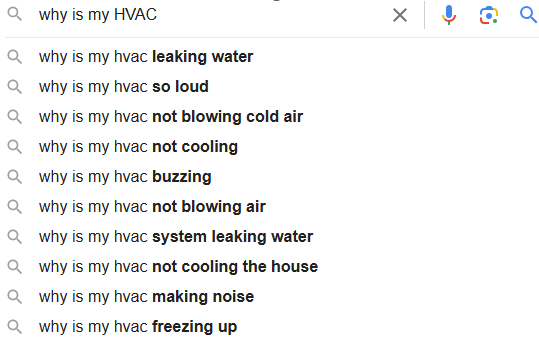
Answer these questions within your content to connect your audience with the information they can use to make informed decisions quickly. Understanding search intent and creating content around it is one part of creating the ideal UX. Once we finish explaining some of the other elements of SEO, we’ll fill you in on what answer engine optimization is and how to use it to your advantage.
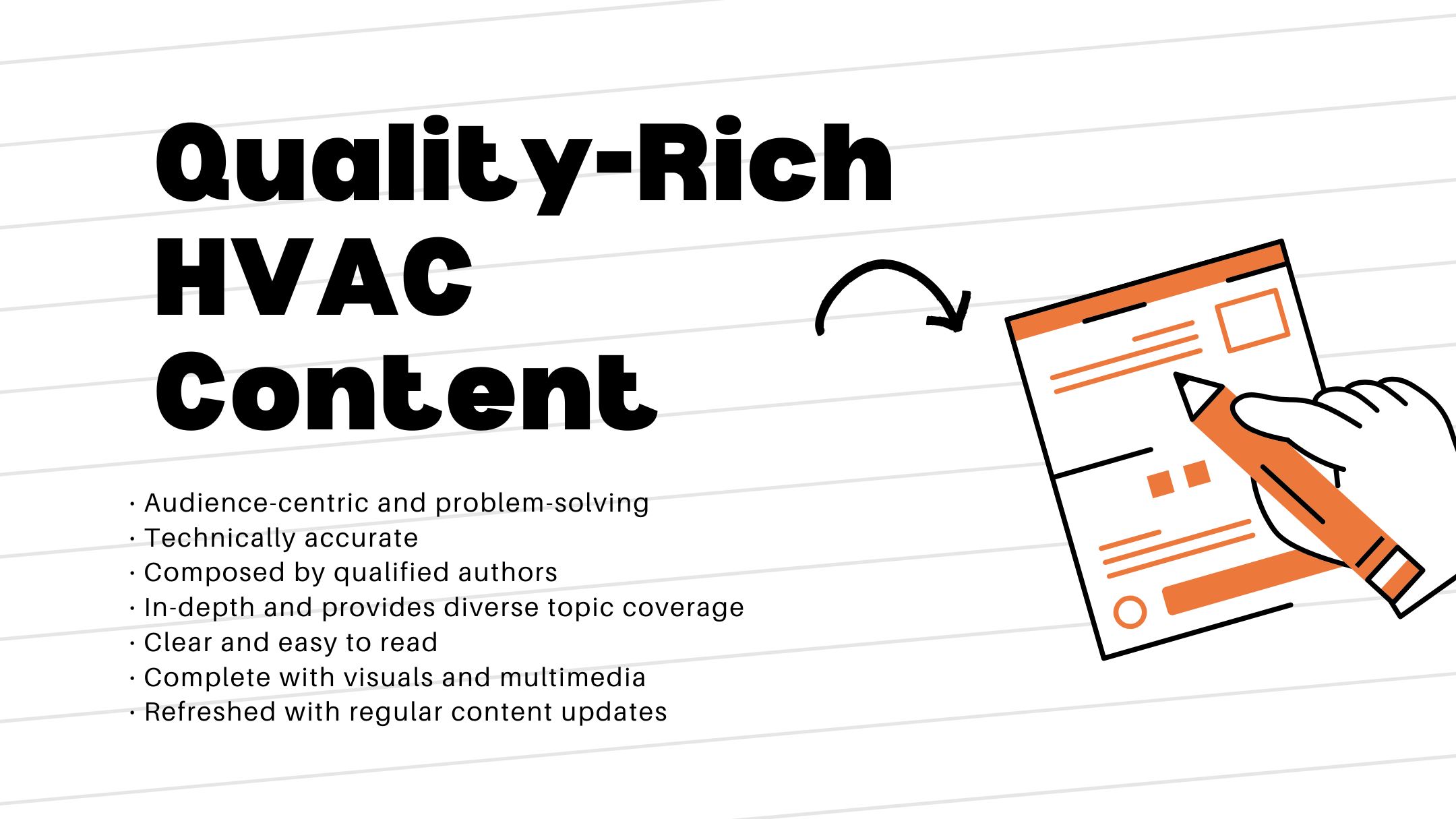
If you’re unsure what to share on your site, use the following pointers to guide your creation of quality-rich HVAC content.
Give your audience heating and cooling content that is:
E-E-A-T stands for experience, expertise, authoritativeness, and trustworthiness. Google uses these criteria to determine your content’s value and judge its ranking in search results, so you want to provide your users with accurate, high-quality information to influence a more favorable page rank.
Let’s get into some of the other on-page SEO tips you can use to bolster your efforts to capture the best search rank.
Metadata is part of a robust technical SEO framework. It includes title tags, meta descriptions, header tags (H1, H2, etc.), and image alt text. These elements provide search engines with essential information about your website’s content, improving discoverability and relevance in search results.
Your HVAC company’s website title tags significantly impact your technical SEO score by providing search engines with a clear and concise summary of each page’s content. They’re the clickable headlines that appear on search engine results pages. By incorporating relevant keywords and accurately reflecting your page’s topic, well-crafted title tags improve your website’s chances of ranking higher for targeted search queries.
Compelling title tags also entice users to click on your listing, increasing your website’s visibility and organic traffic. Keep your title tags to 50 to 60 characters since Google typically displays no more than 60 characters in search results.
As a part of our HTML code, the title tag we chose for this article looks like this:
<title>Your Blueprint to SEO for HVAC Contractors</title>
Use clear and concise language to create a title tag that incorporates your primary keyword as naturally as possible.
Each page on your website should include a meta description you can use as an opportunity to let searchers and search engines know what your page is all about. A good meta description will make use of around 155 characters to display your company name, your primary keyword, and a brief call to action.

Craft a meta description that gives users a good reason to click on your link.
Header tags are HTML elements like title tags, except that instead of having just one, like in your title tag, you should use multiple header tags to make the information on your page more easily digestible.
In their HTML form, they appear like this:
<h2>On-Page SEO for HVAC Companies Defined</h2>
<h3>Metadata Optimization</h3>
<h4>Header Tags</h4>
We used an example of header structure from this blog to show you how headers work to break up your content and create a better user experience. You can also see how we’ve nested our headers into logical groupings, with h2s relevant to our title h1, h3s that are relevant to their parent h2s, and h4s that allow us to expand on details related to the h3 we’ve nested them under.
Image alt text is a brief description of any images you use on your webpage. They serve multiple purposes, including providing context for visually impaired users who rely on screen readers, displaying information when an image fails to load, and aiding search engines in understanding the content of your image.
Above, we showed you an image of a meta description from Semrush.
Here’s what the alt text we entered alongside it looks like:

Don’t overlook alt text optimization. It’s an important technical SEO element because it makes your online HVAC content more accessible and discoverable. If you can only spare resources to optimize a few images, focus your efforts on graphics that add value to your content and skip over photos that are just there for decoration or aesthetic purposes.
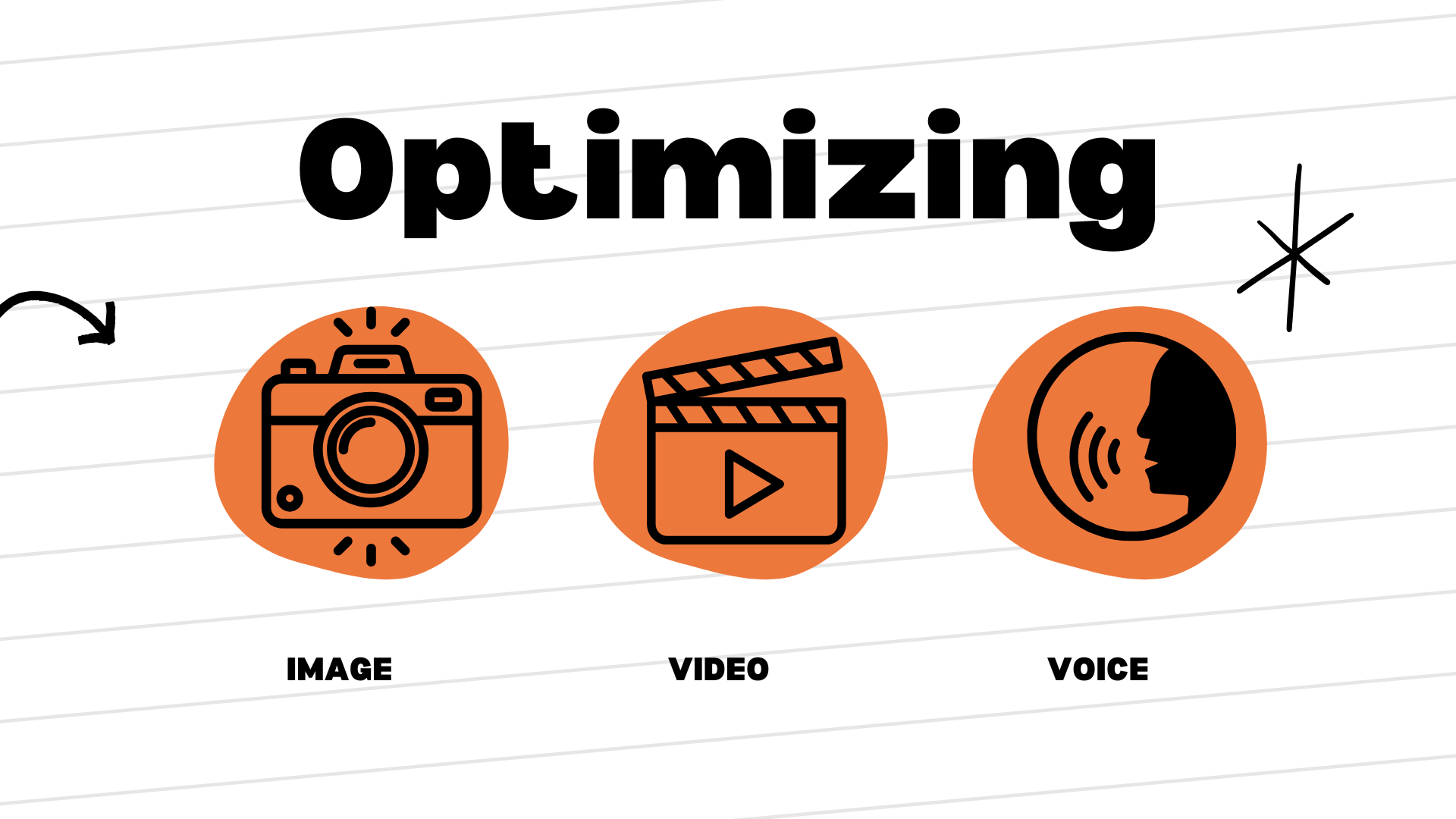
Optimizing images and videos on your site and making sure you’re well-positioned for voice searches can give your HVAC company a significant competitive advantage.
Image SEO means ensuring visual content is correctly indexed by search engines, improving your site’s appearance in image search results and attracting potential customers.
Optimizing for voice search caters to the growing number of users who rely on voice-activated devices to find local services. Focus on using natural language and question-based queries to capture voice search traffic.
Together, these strategies help bolster your site’s UX, boost your search engine rankings, and drive more qualified leads to your business.
Voice SEO is the art of making your website understandable to virtual assistants like Siri, Google Assistant, or Alexa. It’s about crafting content that answers questions in a natural, conversational way, just like you would talk to a friend. It’s becoming an incredibly popular way to interact with search engines.
Since people often use longer, more complex phrases when speaking to these digital helpers, you should design your website to recognize and respond to these queries. When you want your content to appear in the top voice search results and increase your chances of being discovered by potential customers who prefer to use their voice rather than typing, optimizing for voice search is the way to do it.
Tailor your content to match how people speak when asking virtual assistants questions. This involves using natural language, long-tail keywords and questions, and concise, informative answers. Put yourself in the listener’s shoes and provide the information they’re looking for in a clear, conversational way.
Image SEO is the practice of optimizing your website’s images to improve their visibility in search engine results. It’s like giving your pictures a digital makeover so that search engines can understand and appreciate them. Use descriptive file names, craft informative alt text, and make sure your images load quickly to help search engines find and display your image content when people search for related HVAC topics.
Video SEO is the process of tweaking your videos and their related data to rank higher in search engine results. For HVAC contractors, this is crucial for reaching potential customers who are increasingly turning to visual content for information and solutions. You can boost your website’s visibility by creating high-quality videos that address common HVAC issues—like troubleshooting a furnace or explaining the benefits of a new system—and optimizing them with relevant keywords.
When people search for HVAC-related topics, your optimized videos are more likely to appear in search results, attracting potential customers and establishing your business as a trusted authority in your local heating and cooling industry.
Yes. The URL structure you choose for your HVAC website affects your site’s technical SEO score because it directly impacts search engine visibility and user experience. A well-structured URL helps search engines crawl and understand your site’s hierarchy and content relationships. Clear URL paths make it easier for crawlers to navigate your site.
Since search engines use your URLs to index your content, making them clear and descriptive helps give crawlers information about your page’s context. This helps search engines decide where your page fits in their index.
Easy-to-read URLs are also more memorable and easier for humans to understand. When you provide a concise and informative URL, your users will know what to expect from your page, and they’ll be more likely to click your links because they’ll perceive them as relevant and trustworthy.
Do you want to showcase your air conditioning services? You might choose to create a service page with a URL structure that looks like this:
https://www.examplehvac.com/services/air-conditioning
You’ll see that its simplicity lets users and search engines know precisely where they are within your site’s structure. It also makes navigation to other pages that contain the information your user is searching for much easier.
Plus, it’s easy to remember, so if your user isn’t ready to connect with you about their air conditioner now, they’ll know how and where to find your AC services when they need them.
Overall, a good URL structure:
Internal linking allows you to distribute page authority across your HVAC website, helping search engines understand its structure and prioritize important pages. By strategically linking to relevant content within your site, you can guide visitors through their customer journeys, improve navigation, and boost your overall SEO performance.
When you have a pillar page covering everything your HVAC business offers related to furnaces, you might create internal links on that page that lead your users to another page with more specific product or service information. For example, this could be a page about specific furnace units, installations, maintenance, or repairs.
Design your website with a flat structure that’s easy to navigate. Build out your website’s content around the needs and pain points of people who depend on furnaces, boilers, and heat pumps, making it easy for them to find and digest the information they’re looking for. This will help you increase your conversion rates, build stronger brand loyalty and trust, and help your business stand out.
Now that you know how on-page SEO works, let’s go behind the curtain and explore the relevance of what you can do to enhance your site’s SEO score off-page.
Building a strong online presence beyond your website helps drive more organic traffic and enhances your site’s overall visibility. Off-page SEO techniques help develop your website’s authority and credibility, improving its ranking potential in search engine results.
When you build up a large inventory of backlinks from diverse and credible sources, leverage social media marketing, and increase your likelihood of brand mentions online, you show Google (and your target audience) that you’re an industry leader who knows what you’re talking about.
Let’s take a closer look at the elements of a robust off-page SEO strategy.
A backlink is a link on another website that points back to your own. They can include links from guest blogs, influencer outreach, social media platforms, press releases and public relations, content syndication, online reviews, and even question-and-answer platforms like Reddit and Quora.
Maintaining a large inventory of backlinks used to be enough to improve your page rank, but these days, paying attention to the quality of your backlinks matters more than ever. The best links are those from reputable, high-authority websites relevant to the HVAC products and services you provide. These links show search engines that your content is valuable and trustworthy.
Cultivate a diverse backlink profile by aiming for links back to your site from some of the following sources:
Backlinks remain a foundation of off-page SEO, but to leverage their full power, you’ll need to develop strategic partnerships with other industry authorities and trusted news sources. It’s worth spending the time to make these connections.
Social media marketing is a powerful off-page SEO tool that helps connect your HVAC contracting company with customers, build brand awareness, and generate leads. By maintaining a consistent visual identity across all platforms, you can create more awareness around your business and what makes your technicians and HVAC services the best.
You can also use social media to share your company’s culture with current and potential clients, showcasing your team and company values to build trust. It’s a great place to share engaging content like informative posts about HVAC systems, maintenance tips, and energy efficiency.
Facebook, Instagram, X (formerly Twitter), and LinkedIn are all popular platforms where your HVAC business can carve out a space to engage with clients and prospective customers, answer questions, and share positive feedback to build trust and credibility.
A brand mention is any instance where your company’s name, product, or service is mentioned online, whether in a blog post, article, social media post, or forum discussion. These mentions are valuable because search engines consider them a positive signal. Each mention also exposes your business to a new audience, potentially increasing your customer base.
Be sure to monitor for mentions using social listening tools and respond to mentions whenever possible. This will allow you to thank people for their support and promptly address any issues.
You’re an HVAC expert at the top of your game, which means you know things that are important to other people. Have you considered writing a guest blog for another reputable website and spreading your knowledge further than your own website’s reach allows?
Writing a guest blog allows you to showcase your expertise to a broader audience and establish yourself as a thought leader in the local HVAC industry. By contributing valuable insights and practical advice on topics like energy-efficient HVAC solutions, maintenance tips, or the latest industry trends, you can demonstrate your knowledge and authority and connect with more people who need your products, expertise, or services.
Now that we’ve covered off-page SEO, it’s time to learn more about the advantages of local SEO. Read on to discover more tips on search engine optimization for HVAC companies.
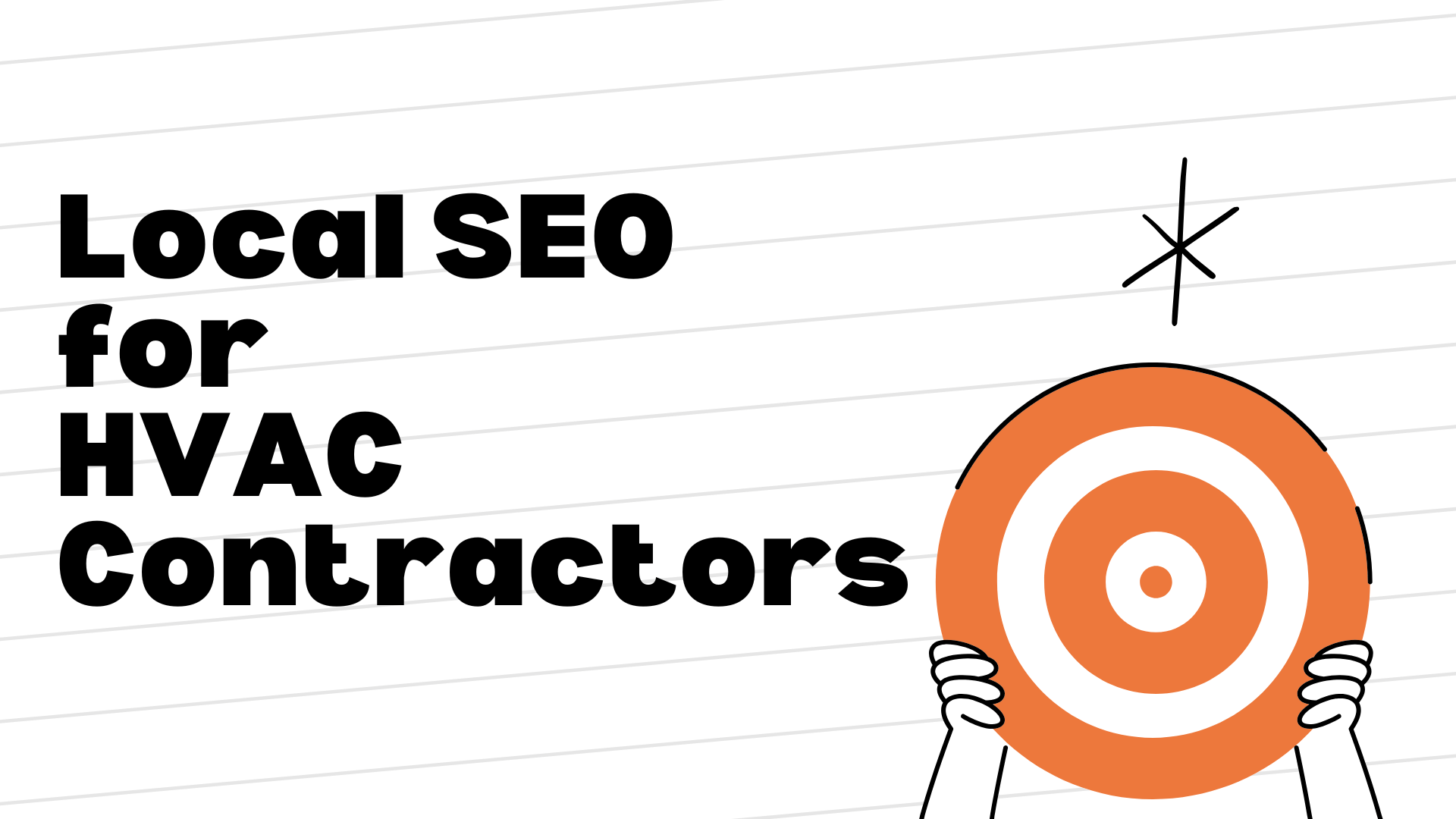
Local SEO is a bit different than regular SEO, and HVAC installers like you can use this to your advantage. While it shares many of the same strategies as search engine optimization, local SEO is all about helping your business gain traction in local search rankings. Successful local SEO means that when someone in your area enters a query with local intent, such as “AC repairs near me”, into a Google search bar, your company appears at the top of the page. Of course, that’s only possible when you optimize for local search.
Local SEO helps put your site in front of nearby homeowners and local businesses who need a qualified HVAC technician rather than reaching Carl in Denmark, who has questions about his furnace.
Here’s how to dominate local search:
A citation is an online mention of your business’s name, address, and phone number (NAP) on a website that isn’t your own. Citations are crucial for local SEO since they help search engines verify your business’s existence and location.
Pay attention to how your business name and contact information appear online. The more consistent and accurate your citations across the web, the higher your chances of ranking well in local search results.
Examples of citation sources include:
Now that you know more about citations, it’s time to introduce you to the directory of all directories.
Google Business Profile (GBP) is a free online business listing that allows you to manage your business information across Google Search and Maps. It’s essentially your digital storefront on Google. Optimizing your GBP increases your chance of landing in the coveted Google Map Pack, which displays the top three local listings.
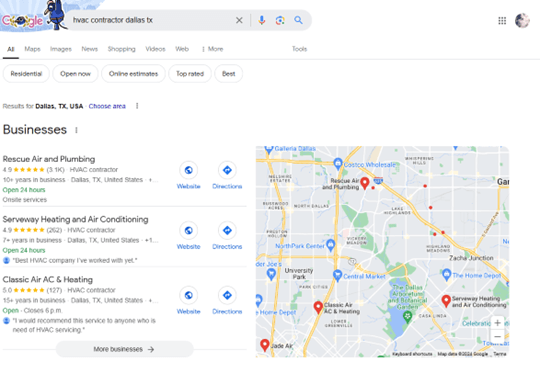
On your GBP, you can directly interact with your customers through Google reviews, messages, and posts. GBP also lets you showcase your business with high-quality photos, videos, and products or services. Regularly updating your profile and engaging with customers builds trust, credibility, and a strong online presence that points people in your community to your local business.
To establish a firm local online presence, you should set up and claim your Google Business Profile as soon as possible. This profile represents your business online and displays it to potential customers searching online for HVAC contractor products and services.
Here’s what ours looks like:
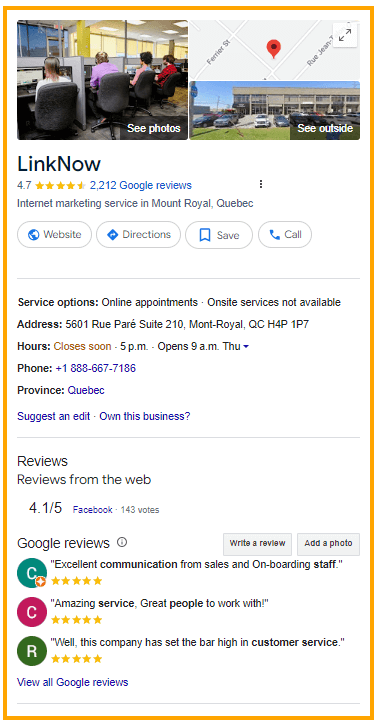
Get started by following these steps:
This setup ensures your business is accurately represented on Google, making it easier for customers to discover and connect with you.
We’ve covered the foundation of local SEO, and now it’s time to get into the finer details of technical SEO. Don’t let its name intimidate you. You’re a mechanical contractor, so you probably aren’t going to shy away from understanding the nuts and bolts of a good SEO strategy.
Technical SEO covers all the work you can do to improve your website’s infrastructure, visibility, and page rank. It involves enhancing aspects like your site’s speed, mobile-friendliness, crawlability, and security. This is how you make sure search engines can access, crawl, and index your website and how you create the best user experience.
Picture this: someone in your community wants to know why their AC blows hot air when their thermostat’s set to cold. They ask this question in a Google search bar, and your website comes up in the results. They click on your site expecting the answer to their question, and they’re met with a slow-loading page that jumps around and isn’t the right size for their screen.
You might be the right HVAC contractor to solve their problem, but they don’t have time to wait for your page to load and surf away to one of your competitor’s pages. Users expect you to value their time, and you can do that by serving them content that’s optimized to load fast, respond to clicks and button taps quickly, and fit the screen of whichever device they’re using.
Optimizing your core web vitals is an excellent way to do this. Read on to learn how:
Your core web vitals are three metrics Google uses to measure the overall user experience your site provides.
They focus on:
When you master these, you’ll no longer risk losing potential clients’ interest in your HVAC service. They won’t be frustrated by your page’s load times or elements like graphics that shift around. The better UX your site provides, the stronger the bridge of trust you can build between your HVAC contracting business and your website users.
There are several ways to speed up load times for slow-loading web pages, including:
Some page speed optimization solutions are rather technical, so you may want your web designer to take the reins. Have a conversation with them to discuss the benefits these options could have on your page loading times.
You have less than two seconds before users become frustrated with pages that don’t load quickly enough. HVAC service websites like yours should aim for pages that load as quickly as possible so users can get the information they need when they need it.
Since search engines use spider bots to find, crawl, and index your website, you want to make sure each page is easy for them to crawl. There are some best practices for creating a seamless navigation experience.
Here’s what we recommend:
Google’s indexing process is akin to cataloging an enormous library. Its digital crawlers explore the internet, following links from one page to another. Upon discovering your website, they analyze its content, structure, and relevance. Google stores this information in a massive index comparable to a library’s card catalog.
When a user searches for a specific topic, Google swiftly consults its index to retrieve the most relevant pages, presenting them in ranked order based on numerous criteria, including relevance, authority, and user experience.
There are some SEO tips to make sure important pages about your HVAC services are indexable. If Google’s not picking up pages critical to your core operations, check the meta tags in the head section of your website’s HTML code and make sure they don’t include a `noindex` directive.
You should also consider if your site has duplicate content that might confuse search engines or users. If you have duplicate content, choose the better-performing page and use canonical tags to point crawlers to the best version of your content.
Canonical tags are HTML elements that look like this:

Suppose you have a website with multiple URLs that lead to the same content due to tracking parameters or duplicate pages, include the above canonical tag pointing to the main URL in each version.
With HTTPS security, your website facilitates a safe digital platform where you can interact with users without worrying about information leaks. This ensures that sensitive customer data and personal information remain protected from cybercriminals.
By prioritizing HTTPS, you demonstrate your commitment to your customers’ security and privacy and enhance your reputation as a reliable HVAC provider.
Providing search engines with structured data, also known as schema markup, paves the way for you to capture Google’s rich snippets, featured snippets, and knowledge panels (which we’ll tell you more about in just one moment). By marking up and explicitly defining the content on your page, you give search engines structured data that helps them understand and present your information in a more relevant and engaging way, potentially increasing your visibility and click-through rates.
Imagine searching for a recipe and seeing results that list the website and show you the cooking time, number of servings, and even a star rating. That’s the power of rich snippets. They’re special search results packed with extra information beyond the website title and description.
Think of them as little trailers for your webpage, giving users a quick glimpse of what to expect before they click. Search engines use structured data to understand your content and create these informative snippets. With rich snippets, your webpage stands a better chance of grabbing attention and getting those clicks.
A featured snippet is a concise, direct answer to a search question displayed prominently at the top of Google’s search results page. When users ask Google a question about your business, this special search result format provides them with immediate information, often called “position zero,” without requiring them to click through to your specific webpage.
A Google knowledge panel is like a quick info card that pops up on the right side of your search results. It contains facts, pictures, and links about a specific person, place, or thing. Think of it as Google’s super-fast way to give you the lowdown on something you’re curious about.
We’ve finished covering the fundamentals of technical SEO for AC and heating contractors, but we still have more tips to share. In the next section, we teach you how to monitor your site’s SEO success.
Tracking some vital metrics will give you all the information you need to understand your company’s position online and how to improve your website’s rank in search engines.
Organic traffic is the lifeblood of sustainable online success. These are visitors who discover your HVAC website through unpaid search engine results. When users input relevant keywords or phrases into search engines like Google, Bing, or Yahoo, and your website appears organically (not as a paid ad), those clicks constitute organic traffic. This invaluable metric directly reflects the effectiveness of your SEO strategies.
By tracking organic traffic, you gain crucial insights into your target audience. Analyzing the keywords that drive these visitors helps you understand their needs, preferences, and search intent, allowing you to refine your content and marketing efforts accordingly.
Keyword rankings are your website’s search engine popularity contest score. They represent your page’s position on search engine results pages for specific keywords or phrases. A higher ranking means greater visibility and potential traffic.
You can manually check search results or leverage specialized SEO tools like Google Search Console or Ahrefs to measure keyword rankings. These tools provide data on your position for target keywords, allowing you to track progress, identify opportunities, and refine your SEO strategy. When you consistently monitor keyword rankings, you can gauge the impact of your optimization efforts and make data-driven decisions to improve your website’s overall performance.
Click-through rate (CTR) is the percentage of users who click on your listing after seeing it in a search engine. A high CTR shows that your website is relevant to searchers and that your title tag and meta descriptions are resonating.
It’s a good way to identify which search terms drive the most interest so you can tailor your title tags and meta descriptions accordingly. A rising CTR suggests your SEO strategy is working, while a declining CTR might signal the need for optimization or adjustments.
Your bounce rate refers to users who “bounce” away after viewing only one page of your website’s content. When this number is low, it means users who navigate to your page from SERPs receive clear information about what to expect when they surf over to your page and that when they get there, you’re serving them the type of information they wish to see.
Your conversion rate describes the percentage of your site visitors who’ve taken the next steps, whether that’s filling out your contact form, purchasing an HVAC unit, scheduling AC repair services, or joining your mailing list. Again, Google Analytics is a great resource for tracking this information, but you can also find varying tiers of conversion rate tracking service options online.
As promised, we haven’t forgotten to give you more details about the power of answer engine optimization. Keep going to learn more about the new direction search is taking.
Make way for answer engine optimization (AEO). With the increasing prevalence of voice-activated devices and AI-powered digital assistants, search is headed in this direction. AEO focuses on providing precise, relevant answers to users’ queries directly within search results, shifting the emphasis from traditional keyword-based SEO to content that addresses specific questions.
As users seek quick and convenient answers—especially through voice search—AEO prioritizes clear, to-the-point, and well-structured content that search engines can easily interpret and present as featured snippets or voice responses.
An AEO approach enhances your site user’s experience by rapidly delivering accurate information and increases your company’s visibility and authority by positioning your business as a trusted source of information. It’s the way to meet the expectations of modern consumers.
The framework for creating and maintaining a successful AEO strategy is simple. It’s all about understanding user intent and knowing which specific questions your target audience is asking about your HVAC business, products, services, pricing, and processes. We recommend analyzing search queries related to heating and cooling and creating quick-to-read and easy-to-understand content that addresses these questions.
Here are some examples of the types of questions real people want to know about commercial, residential, and industrial heating and cooling:
Last but not least, we leave you with some tips on common SEO pitfalls savvy HVAC contractors should avoid:
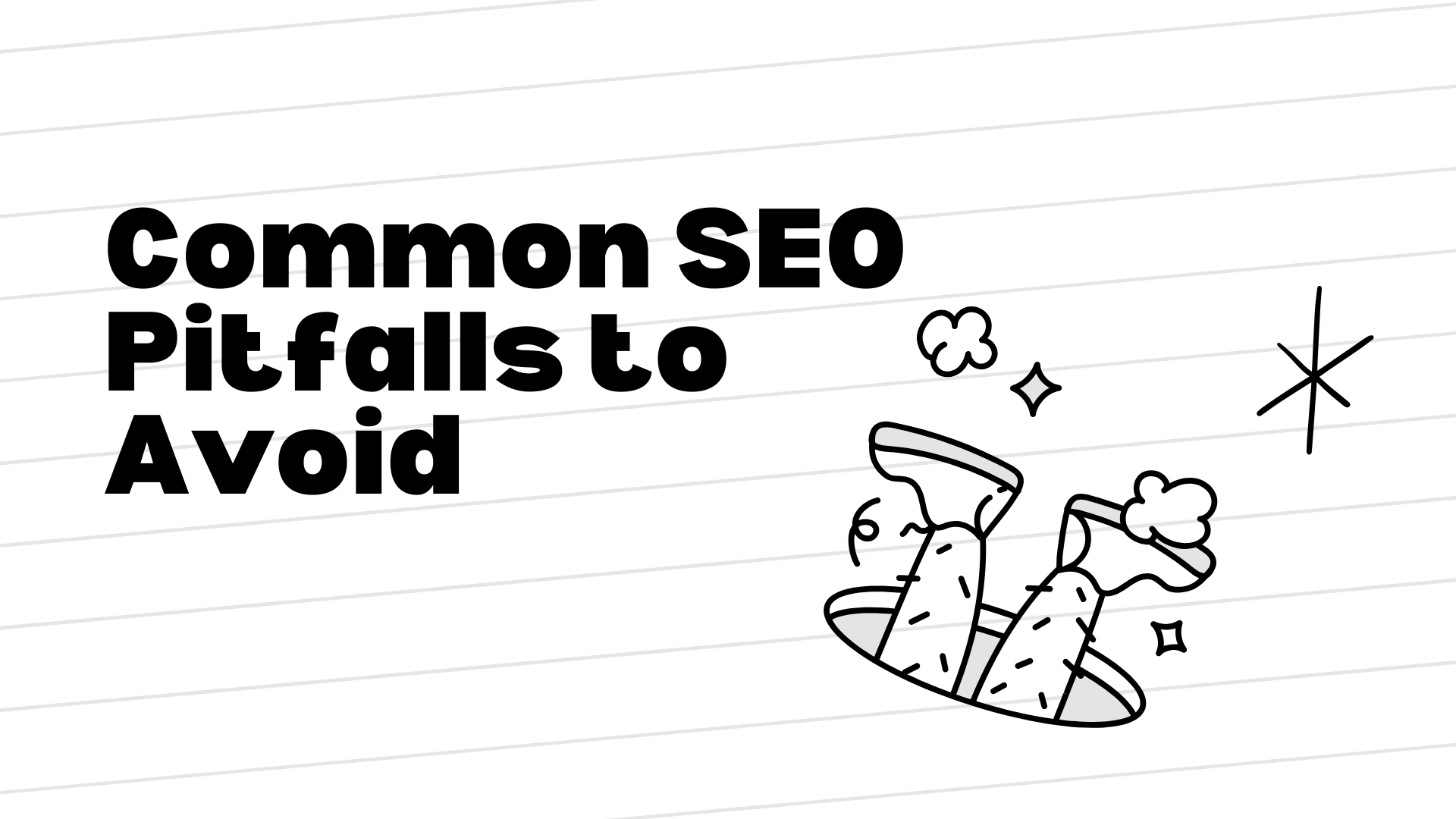
This section highlights some of the most common SEO mistakes HVAC technicians should avoid. From examining the damage that low-quality or too-few backlinks do to discussing the pitfalls of keyword stuffing, sparse or sales-y content, and sub-par website design, we’ll tell you everything you need to know to steer clear of these common errors.
While building a diverse backlink profile remains crucial for boosting your online visibility and attracting potential customers, not all backlinks are created equal. Low-quality links from spammy or irrelevant sites can actually harm your search engine rankings and damage your website’s reputation. To maximize the benefits of backlink building, focus on acquiring high-quality links from authoritative sources within or related to your industry.
Users expect your HVAC company to greet them with an easily navigable digital interface rich with stable content that loads quickly and doesn’t jump around. A cluttered layout, poor readability, lack of accessibility, difficult navigation, and slow load times drive users away from your site.
Search engines may interpret users leaving your site due to poor design as a signal that your content isn’t relevant or useful and give your site a lower rank. To avoid this, spend time tweaking technical SEO elements to improve loading speeds, stabilize shifting page elements, and enhance UX.
Keyword stuffing is a now ancient and defunct strategy that once helped websites of the past capture top spots in search results. If you plan to test to see if it still works, let our SEO specialists talk you out of it. Search engine algorithms have evolved to detect this practice and penalize sites still employing this tactic.
Instead of loading your headers and content with the same keyword, today’s best keyword strategies involve creating clusters of related, long-tail, and question keywords. These are all words or phrases that share common ground with your primary or main keyword.
A good cluster for the primary keyword, “HVAC Services,” will look something like this:
You can use these related, longer-tail, and question keywords to give your audience more details about your HVAC products and services.
We’ve moved past taking any company’s word for being the best at what they do. We’ve grown tired of overly sales-y content that lacks the real meat and potatoes that would inspire us to move from information gathering to a paying customer. Don’t give people searching for heating and cooling solutions more of the same. Show them you’re an industry innovator by creating a digital space where they can find the answers to all their HVAC questions.
Take us at LinkNow Media as an example. Instead of just telling you we’re the best at what we do, we’ve gone ahead and written this guide to demystify SEO for mechanical contractors and connect you with the answers you need to move the needle on your online marketing.
SEO is always evolving. It pays to stay on top of trends affecting your search rank and how your clients and potential customers perceive your business. You’re an HVAC expert who wants to cover all your bases, grow your online presence, and showcase what sets your technicians apart from your competitors. LinkNow Media is a digital marketing solutions provider that strives to remove barriers and help your business realize its full potential.
Our mission is to give you the best SEO advice specific to the heating and cooling industry. Whether you already have a site or want to develop a new online launch point for your business, we’re here to walk you through the process, explain the details, and help you strategize.
Schedule a complimentary call with one of our customer success facilitators to learn more about how to make SEO work for your HVAC contracting business.